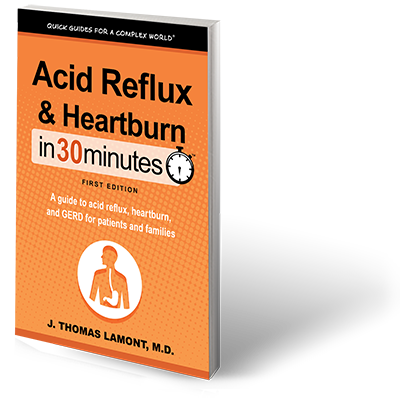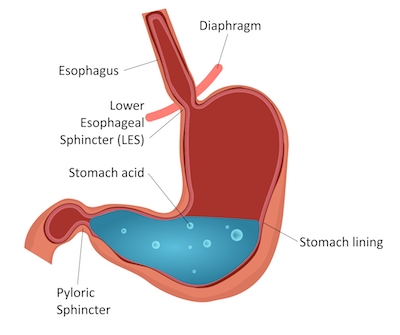The following glossary of acid reflux terms is excerpted from Acid Reflux & Heartburn In 30 Minutes: A guide to acid reflux, heartburn, and GERD for patients and families (learn more about the book here)
 Acid blockers – Medications that reduce the production of stomach acid.
Acid blockers – Medications that reduce the production of stomach acid.
Acid reflux – A more serious form of heartburn, also known as GERD.
Agida – Acid indigestion heartburn.
Alzheimer’s disease – A progressive brain disorder usually observed in older patients that destroys memory and thinking skills. There is no cure.
Angina pectoris – Indicates a problem with blood flow to the heart muscle.
Antacid tablets – Over-the-counter tablets that can reduce heartburn.
Baclofen – A drug that helps treat heartburn by reducing reflux.
Barium swallow – Also known as an upper GI series, this is a diagnostic procedure in which the patient swallows a few cups of barium, a white chalky liquid that shows up on an X-ray of the esophagus and stomach.
Barrett’s Esophagus – An abnormal appearance of the cells lining the esophagus. In a small number of cases, it may progress to esophageal cancer.
Bile – A substance secreted by the liver and stored temporarily in the gallbladder that breaks down fat in your diet
Bile acids – A component of bile designed to help digest fat in the diet.
Bravo 48-hour pH probe – A 48-hour acid reflux study which measures the frequency and intensity of acid reflux from the stomach into the esophagus using a sensor.
Cholesystramine (Questran) – A drug that binds bile acids and prevents them from irritating the esophagus.
Diffuse esophageal spasm – Strong and persistent muscular contractions of the esophagus that cause chest pain.
Digestive enzymes – Helps your body break down and digest your food.
Duodenum – The first part of the small intestine just below the stomach.
Dyspepsia – A Greek word that means upset or sore stomach.
Dysphagia – A medical term used to describe difficulty swallowing.
Esophageal manometry – A test that measures pressure waves in the esophagus, which can confirm the presence of a weak lower esophageal sphincter.
Reflux esophagitis – A condition associated with heartburn, difficulty swallowing, and with allergic symptoms such as burning or tingling of the tongue or throat after eating certain foods. Many of these patients have severe heartburn and evidence of acid damage to the esophagus.
Esophagus – The hollow, muscular tube that connects the throat to the stomach.
Fosamax – A drug used to treat osteoporosis that can also irritate the esophagus.
Gas bloat syndrome – An inability to belch and a feeling of distension or bloating, sometimes associated with anti-reflux surgery.
Gastric juice – A very powerful acid solution produced by the stomach that helps digest our food and kills viruses and germs in food and water.
Gastritis – Inflammation of the lining of the stomach.
Gastroenterologist – Also known as a GI doctor. These specialists concentrate on diseases of the digestive system.
Gastroparesis – A condition that limits the ability of the stomach after a meal. This is seen most often in diabetics and is called diabetic gastroparesis, but can occur in some patients who are not diabetic, so-called idiopathic gastroparesis.
GERD – Gastroesophageal reflux disease. Also known as acid reflux.
Helicobacter pylori – A bacterial infection of the stomach often acquired in childhood that can lead to gastritis, or inflammation of the lining of the stomach.
Hiatus hernia – A condition in which the stomach pushes upward through the diaphragm into the chest.
Histamine blocker (H2 blocker) – Terms that refer to a type of acid-blocking medication. Examples include cimetidine and ranitidine. H2 blockers are considered excellent treatment for mild-to-moderate heartburn without complications.
Hydrochloric acid – A corrosive substance which is secreted by your stomach.
Hypersensitive esophagus – Also known as irritable esophagus, a condition in which the lining of the esophagus is very sensitive to even a small amount of acid.
Ibuprofen – Pain reliever that can lead to irritation and inflammation of the esophagus.
Laparoscopic Nissen fundoplication – A procedure in which the surgeon wraps the top of the stomach around the bottom of the esophagus, which strengthens the sphincter valve and prevents acid from going up into the esophagus after a meal.
Larynx – Voice box.
LINX device – A small ring of magnets which is placed around the lower esophagus to keep the esophagus closed and prevent acid from refluxing upward, just like the lower esophageal sphincter is designed to do.

Stomach diagram from Acid Reflux & Heartburn In 30 Minutes
Lower esophageal sphincter (LES) – Sphincter that regulates the flow of food and liquid from the esophagus to the stomach. For most people, the LES prevents stomach acid from flowing upwards into the esophagus.
Myocardial infarction (MI) – A heart attack.
Naproxen – A nonsteroidal anti-inflammatory drug and pain reliever that can cause irritation and inflammation of the esophagus.
Nonsteroidal anti-inflammatory drug (NSAID) – A class of medications including Aleve, ibuprofen and similar medications typically used in high doses to treat patients with arthritis and rheumatism.
Osteoporosis – Bone loss.
Proton pump inhibitor (PPI) – A class of acid-blocking medications used to treat acid reflux. Examples include omeprazole and lansoprazole.
Pyloric sphincter – The muscle regulating the flow of partially digested food and liquid from the stomach to the duodenum, the first part of the small intestine.
Rebound hyperacidity – A condition that sometimes occurs when patients abruptly stop taking proton pump inhibitors (PPIs), instead of tapering off gradually.
Refractory GERD – Bad heartburn that persists despite maximal therapy.
Simethicone pills – Used to break up gas bubbles after anti-reflux surgery.
Sphincters – Small muscles that act as valves to control the flow between different parts of your digestive system.
Stricture formation – The formation of scar tissue in the esophagus which narrows the opening of the esophagus and causes difficulty in swallowing.
Upper endoscopy – A procedure in which an endoscope (a flexible tube with a light on the end) is passed through the mouth into the throat to directly examine the esophagus, stomach, and the top of the small intestine.
Wide open reflux – A condition in which stomach acid constantly moves upward into the esophagus.